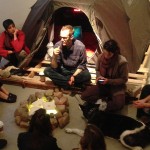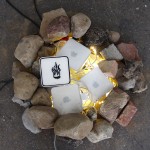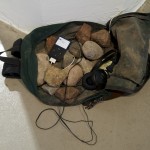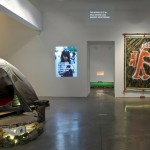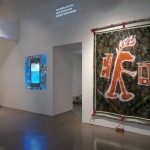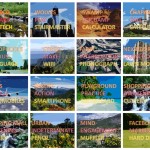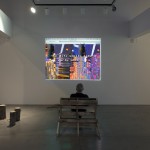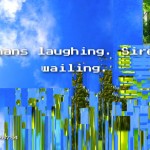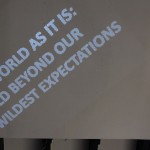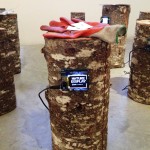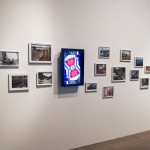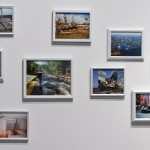What does the term ‘ecologies’ mean to you and how is represented in Basecamp.exe?
We see our creative work as a part of a performative response to cultural and theoretical conversations. Basecamp.exe, like much of our research, is highly influenced by but also building off of Félix Guattari’s Three Ecologies, in which “ecology” is described as an intertwining of the social, the psychic, and the environmental. To affect one is to affect all three. In one of our favorite parts of Three Ecologies, Guattari transfers the discourse of species extinction to the human imagination, moving from the environmental to the psychic: “It is not only species that are becoming extinct,” he writes, “but also the words, phrases, and gestures.” Put in another way: the agricultural and ecological monocultures being created by our industrial systems are simultaneous with the creation of what Vandana Shiva has called “monocultures of the mind.” Perhaps, every time we lose another species from our planet’s biodiversity we also lose another way of thinking, imagining, being, and relating. Guattari also obliquely suggests media to be part of his three ecologies—but he does not completely go there, which may be understandable decades ago. We see media as something we contribute to the discussion. We’d like to see a media-diverse landscape protected and nurtured; we believe in the necessity of a media-landscape in which net neutrality does not become a nostalgic notion of a bygone era, a media-landscape as diverse as North America was biologically before the arrival of first humans 10,000 ago (at which point, the archaeological record shows, a major wave of anthropogenic extinction of large mammals occurred). That is why we hack technology for the wrong ends, reappropriating, for example, tools of speedy consumerism and communication as devices of place-making and slowing-down.
Basecamp.exe is a workshop-installation, a 21st-century ecological happening, and an interconnected ecosystem of new media and environmental artifacts. Created collaboratively with public participants through workshops, Basecamp.exe explores environmental awareness and experiences of the urban landscape. While traditional base-camps provide supplies for backcountry expeditions in exotic, faraway locales, Basecamp.exe adapts this concept to create a campsite for the modern world, comprised of digital, natural, and industrial materials—campfires, computers, tents, rocks, salvaged wood, urban debris, a #wilderness twitter feed—some of which is collected by hikers using our Indetermintae Hikes+ mobile app. When “the environment” is regarded as a wild, faraway destination, we forget the ecological connections in our own homes and backyards, on city sidewalks and interstate highways. Basecamp.exe is a campsite for the ecological world in which we actually live. Workshop activities include exchanging stories around a computer-campfire built with industrial rubble, tweeting posts that enter a global archive of #wilderness consciousness inside an expedition-quality tent, documenting wild happenings in the outdoors, and collecting found unnatural objects made of natural materials for display on log displays made of recycled LCD screens, among other environmental engagements.
In a sense, Basecamp.exe provides people with a framework for expeditions to nowhere because we have already arrived. And we are already home. There is nothing to go toward, nothing to return to. Nature is a myth. Progress is a sham (the Dadaists got the memo on that one quickly). And nostalgia is the rosy view of sentimentality coupled with the security of knowing that we have safely survived the past. Basecamp.exe offers participants the chance to experience the immediate and temporary adventure of life on planet earth with all its multi-ecological interconnections.
- Participatory installation and workshop, courtesy of EcoArtTech 2013
- Participatory installation and workshop, courtesy of EcoArtTech 2013
- Rocks, industrial rubble, Mac Minis, LED strips from “basecamp.exe,” courtesy of EcoArtTech 2013
- Audio mp3, found backpack, rocks, old iPod, from “basecamp.exe,” courtesy of EcoArtTech 2013
- Participatory installation and workshop, courtesy of EcoArtTech 2013
- Participatory installation and workshop, courtesy of EcoArtTech 2013
- 26 12×14 archival inkjet prints, from “basecamp.exe,” courtesy of EcoArtTech 2013
- Participatory art app for mobile tablet, from “basecamp.exe,” courtesy of EcoArtTech 2013
What role does the digital take in ecologies? Are they interdependent?
The digital takes on all roles. Nothing is independent. So, yes, “they” are interdependent!
The language of wildness factors into the basecamp.exe project. How does your ecological sensibility position wildness or wild forms of life? I take it that these terms are no longer antithetical to civilization or urban spaces. So how are we to apprehend social space under a rubric of wildness?
The language of wildness/wilderness factors into all our projects. As William Cronon so aptly pointed out so many years ago, wilderness is a myth. The idea of a sublime, sacred space of freedom and renewal, a zone of untouched nature where human intervention has not occurred, is a myth. For quite some time, the term “wilderness” circulated without question within environmentalist circles and was the centerpiece of environmental protection, including the creation of national parks. Cronon traced the roots of this idea in range of historical ideas and events—Judeo-Christian values, romanticism, primitivism, the mythology of the American frontier, US nationalism, and colonial conquest: “there is nothing natural about the concept of wilderness,” he argued. “It is entirely a creation of the culture that holds it dear, a product of the very history it seeks to deny.” In addition, the idea of wilderness makes invisible the environments we actually live in—so that we can pollute and live unsustainably while we “leave no trace” on a backpacking trip in national park. Our early collaborative video “Wilderness Trouble” reflects on our recovery from this naïve romanticization of nature that most of American culture still suffers from and captures the moment when we began to bring the global networks into our environmental awareness. And yet, like Cronon, we don’t think the concept of “wilderness” has to be thrown away, and we will quote him here—because he expresses so well what we can learn from the otherness of nature: “Wilderness teaches us to ask whether the Other must always bend to our will, and if not, under what circumstances it should be allowed to flourish without our intervention. This is surely a question worth asking about everything we do, and not just about the natural world.”
At times in our work the term “wildness” functions as a chance operation, like the unexpected visitors, such as the bear, the moose, or the tax assessor who all recently stopped by our art studio in the western mountains of Maine. For us, concentrating on chance encounters—or “interruptions of knowledge” as Gayatri Spivak called them in Leila’s graduate seminars at Columbia, or “near-miracles” as Allen Kaprow called them—bring us into a state of mindful awareness of the life we are living. Other times “wildness” works as a stand-in for unknowable “other” like a deer, a colleague, a neighbor, God, or Buddha. Imagination of the other—and awareness of what we cannot know and will never know, and accepting this with a purposefully playful attitude—is the impetus behind our work, and we actually don’t wish to over-prescribe it or talk too much about apprehending it.
One of us (Cary) is an artist-theorist, and one of us (Leila) is a theorist-artist, and we trade out instruments so as not to lose the energy, wonder, wildness, and fresh-faced amateurism of the band. It is important for us to find ways to encourage accidents within our process. Cary thinks we “throw” terms, knowledge, culture, and ideas around in our work the way Richard Serra threw molten lead in his early works and then later on threw around hot vaseline for Matthew Barney’s Cremaster 3. Leila, though, is not sure about this throwing-around idea and is looking for another metaphor… Meanwhile, we both agree that we are investigating the possibilities that emerge when theory and practice are freed from their respective states.
- Web app with live data from IH+, from “basecamp.exe,” courtesy of EcoArtTech 2013
- Web app with live data from IH+, from “basecamp.exe,” courtesy of EcoArtTech 2013
- 26 12×14 archival inkjet prints, from “basecamp.exe,” courtesy of EcoArtTech 2013
- Text projection with photoshop bounding box “ants,” courtesy of EcoArtTech 2013
- Logs, re-purposed Nokia LCDs from “basecamp.exe,” courtesy of EcoArtTech 2013
- Text projection with photoshop bounding box “ants,” courtesy of EcoArtTech 2013
- Inkjet images from google search “bad weather” from “basecamp.exe,” courtesy of EcoArtTech 2013
- Inkjet images from google search “bad weather” from “basecamp.exe,” courtesy of EcoArtTech 2013
The basecamp and indeterminate hikes projects seem to pivot on an ethos of exploration. Historical explorations and expeditions are, of course, tied to a larger European project of colonizing “far-off” places. So how do these projects invent or refuse a logic of social proximity and distancing? What are the explicitly cultural effects of treating urban environments like nature parks?
Education and universities have been part of the colonial project. The ideas of freedom, justice, and equality have been part of the colonial project. Even soap was very much part of the colonial project. And the idea of nature parks, this idea of nature being somewhere else faraway from where we live, in some protected zone called a “park,” is part of the colonial project. Protected nature zones, and environmental conservation, have long been part of the removal of indigenous people, who live and work with “nature,” off land to reserve spaces for modern escape, recreation, and leisure, and not-work. (At other times, indigenous people are pushed off land grabbed for industrial purposes, such as the growing of agricultural monocultures for foreign markets.)
So our art/research does not consider urban environments as nature parks; nor do we consider nature parks as nature parks for that matter! We are concerned more with cultivating an awareness of the interconnectedness of all beings and all spaces. We have simply moved the romantic language of nature and wilderness—essentially, a myth—into spaces (cities) that it is not supposed to be. This is an act of deconstruction and displacement, and also, relatedly, an act of ethical imagination. We are weaving the work of environmental historian William Cronon and poststructuralist philosophers Jacques Derrida and Emmanuel Lévinas, when we ask, Can we experience city streets or common, moveable, interchangeable places as sublime natural wonders? Don’t we need to consider garbage dumps as much as, or perhaps more than, pretty waterfalls? How do prescribed modes of looking and being define how we understand place, nature, ecology, and environment? We have asked ourselves, and we are asking others, to question what parts of our environment we admit into consciousness, to rethink whether or not we limit our understanding of our ecological being to only those aspects that are comfortable, pleasurable, and easily packaged for public consumption into familiar, digestible pieces. Basecamp.exe and our Indeterminate Hikes mobile app attempt to break from default modes of both mobile media use and ecological awareness, asking us to notice what usually falls out of the official map, to shake up our modes of perception, and this sometimes requires that we fall away from safe, predictable paths.
Your projects often engage with the built environment. Given that ecologies is frequently associated with biology and life forms, how, if at all, can we think of the built environment (which is comprised of ‘inanimate’ objects) as an ecological formation in itself?
Humans are technical beings, dwelling in constant tension between biological need and cultural invention. We cannot live without technics, and understanding this technical state of being and survival dismantles any distinction between nature and culture, biological and built environments. Humanity cannot live without building habitable spaces, and at the same time, we need the biodiversity and the nutrients of nature to have a sustainable society that supports our physical, mental, and spiritual health. Humans remake the earth, but the question is are we remaking it in a way that won’t tip the balance over toward destroying the very grounding of our existence? If we are putting so much faith in human techno-scientific ingenuity that we grow our food with GMOs and chemicals instead of relying on the cycles of breakdown and growth that nurture the planet’s biodiversity and our bodies? Will we remake the earth so extremely that we forget our reliance on the earth’s biological ecosystems? Bernard Stiegler’s Technics and Time series is one of our favorite resources to turn to for thinking about the technological evolution of the human species. He turns to Greek mythology to explain how humans’ technical being and technical skills has always involved a tension between power and weakness. Are our tools empowering or are they ultimately creating our own demise?
We find it really frustrating that lots of environmental thought, and most popular thought about the environment, either rejects technology as the cause of ecological crises so our only solution is to go primitive or embraces technological progress as our future savior, which often means we have to trust in corporate and scientific innovation to solve world hunger and sequester carbon out of the atmosphere. If human beings are technical beings, relying on nature and culture simultaneously, is it even possible to distinguish between what’s natural and what’s not? Isn’t human sustenance dependent upon not only our biological needs (air, water and food, preferable unpolluted and nutritious) but also our languages, cultures, beliefs, and imagination? This is why we find it essential to think about electronic spaces and digital technologies whenever we think about the “environment.”
However, that doesn’t mean that all technologies and tools are the same or that all spaces are equalized. A shovel may be an immediate manageable technology, a localized tool we can control directly by physical manipulation; the NASDAQ is another story. Built environments are networked, pulsing, and growing at the speed of global commerce and exchange, and we can imagine them alive, like a forest in some ways, teeming with activity. However, city growth, digital media developments, and data flows are also very destructive toward the diversity of human, animal, and plant life in a way that a forest is not. As food activist and organic farmer Joel Salatin puts it, when talking about the industrial food system, we live in a culture defined by a “mechanistic, reductionist, linear, fragmented, compartmentalized, disconnected, systematized, individualized, parts-oriented kind of thinking.” Crude oil extraction, damming of rivers for power generation, server farms, industrial farming, the mining of minerals for digital, networked devices—none of this is maintaining a planet where life is sustainable.
We’ve discussed your approach to the digital and the natural as larger organizing ideas in your practice, and how your projects encourage users to locate and cultivate ‘place’ in a so-called disembodied digital sphere. How does the body and the body-in-space figure into your practice? Not just in terms of thinking about participants as instigators but also the kinds of connections and spatial logics that emerge from bodies interacting with each other, with objects – from tech devices to architectural forms within the built environment – and space.
It is a faulty assumption that the digital is a disembodied sphere. Ubiquitous digital, networked media move data at great speeds because these technologies are the manifestation of capital. Capitalism’s need to extract the most value possible as quickly as possible from human/animal bodies and from the earth is felt by everyone everywhere. From the workers in tantalum mines in the eastern Congo to the unwitting, unpaid content providers (that would be many of the people reading this interview) who work tirelessly 24/7 to create status updates and social media “likes” for marketing corporations. There is no on or off the network, no embodied/disembodied distinction, no virtual space. For us, the job of artists, hackers, theorists, and creative workers is to interrupt that drive, reduce the speed, and allocate time to rediscover our place, our bodies, and our relationships to others, nonhuman and human. EcoArtTech stages opportunities for moments of mindfulness, and for reflection about what it feels like to be a technical human-animal dwelling in the here and now. As John Cage once said, art can be “purposeful purposeless or a purposeless play,” which is “an affirmation of life–not an attempt to bring order out of chaos nor to suggest improvements in creation, but simply a way of waking up to the very life we’re living.” In his guided meditations and calligraphic art, Buddhist monk, poet, scholar, and human rights activist Thick Nhat Hanh often says: “Breathe you are alive.” And then later he says: “Breathe you are online.”
For more documentation from EcoArtTech’s Basecamp.exe and related projects go to www.ecoarttech.net.

